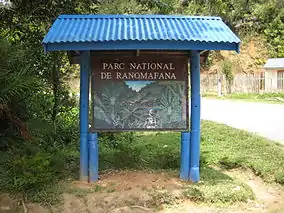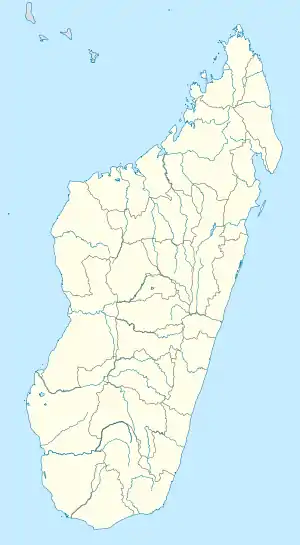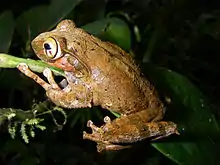Ranomafana National Park
Ranomafana National Park is in the southeastern part of Madagascar in Haute Matsiatra and Vatovavy-Fitovinany. With more than 41,600 hectares (161 square miles) of tropical rainforest, it is home to several rare species of flora and fauna including the golden bamboo lemur, the greater bamboo lemur, black and white ruffed lemur and Milne-Edwards sifaka, and over 130 species of frogs. Bird species including ground rollers, blue vangas, short-legged ground rollers and brown mesites can be seen. The park was established in 1991 with the purpose of conserving the unique biodiversity of the local ecosystem and reducing the human pressures on the protected area. It is part of the World Heritage Site Rainforests of the Atsinanana. Adjacent to the park is the Centre ValBio research station,[1] established in 2003 and managed by Stony Brook University with a focus on biodiversity research, community health and education, environmental arts and reforestation.
| Ranomafana National Park | |
|---|---|
IUCN category II (national park) | |
 Entrance sign to Ranomafana National Park | |
 Location of Ranomafana National Park in Madag | |
| Nearest city | Fianarantsoa |
| Coordinates | 21°13′S 47°25′E |
| Area | 416 km² |
| Established | 1991 |
| Governing body | Madagascar National Parks Association |
| Type | Natural |
| Criteria | ix, x |
| Designated | 2007 |
| Reference no. | 1257 |
| State Party | Madagascar |
| Region | List of World Heritage Sites in Africa |

Geography
The park is 65 km (40 mi) northeast of Fianarantsoa and 139 km (86 mi) west of Mananjary in the regions of Haute Matsiatra and Vatovavy-Fitovinany.
National Roads nos. 45 and 25 cross the park.[2]
The park office is at the entrance in the village of Ambodiamontana, at 6.5 km (4.0 mi) from Ranomafana.
Flora and fauna
The park is an important example of cloud forest, with very high levels of biodiversity.
There are a number of lemur species, including:
- Aye-aye, Daubentonia madagascariensis
- Crossley's dwarf lemur, Cheirogaleus crossleyi
- Golden bamboo lemur, Hapalemur aureus
- Greater bamboo lemur, Prolemur simus
- Milne-Edwards's sifaka Propithecus edwardsi
- Peyrieras's woolly lemur, Avahi peyrierasi
- Ranomafana grey bamboo lemur, Hapalemur griseus ranomafanensis
- Red-bellied lemur, Eulemur rubriventer
- Red-fronted brown lemur, Eulemur rufifrons
- Red mouse lemur, Microcebus rufus
- Sibree's dwarf lemur, Cheirogaleus sibreei
- Small-toothed sportive lemur, Lepilemur microdon
- Southern black and white ruffed lemur, Varecia variegata editorum
Tourism
A local guide is required for visitors entering the park. Guides can be arranged at the park office. A typical excursion would include viewing several species of lemur, gecko, chameleons, and bird species. Typically, tourists exploring the Talatakely forest. Talatakely has well-defined paths and stairs, however, sturdy shoes should be worn as the path can be slippery, especially when wet. If there are special interests, such as birding, specialists can be arranged through Centre ValBio for excursions. Guided tours are not available at nighttime. However, walking alongside the road and looking for eye-shine in the adjacent can typically allow tourists the chance to see mouse lemurs.
Kayaking or canoeing can be arranged and a hot springs pool is located in Ranomafana.
Scientific research
The flora and fauna of Ranomafana have been subject to extensive scientific research. Scientific publications have been published.
There are four main sites for scientific research. Talatakely is located within walking distance of the research station, Centre ValBio, and is also accessible to tourists off of Route 25. Talatakely is where the original research camp was located and is one of the few locations in the park where Prolemur simus can be seen. The three remaining research sites maintain bush camp facilities and are Vatoharanana, Valohoaka, and Mangevo. In addition to these main sites, research has been conducted throughout the park.
Lodging
There are a lodge and an ecolodge of a private tourist operator at the entrance of the national park. There are also several hotels in Ranomafana village available for lodging. Additionally, it is possible to camp at the campsite near the main road through the park or to find lodging at Centre ValBio, where most of the scientific research is based.
References
- Centre ValBio
- Parcs Madagascar Archived 2012-05-22 at the Wayback Machine
External links
| Wikimedia Commons has media related to Ranomafana National Park. |
| Wikivoyage has a travel guide for Ranomafana National Park. |
